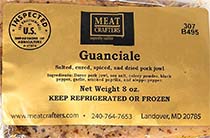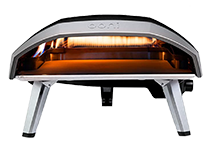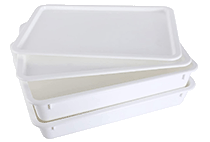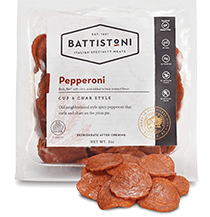Let us introduce you to your new favorite Italian cured meat, guanciale (pronounced gwan-cha-leh). It is made from pork jowls and has a strong pork flavor. Putting Italian guanciale on pizza is a game changer and will add something special to your homemade pizzas.
You have probably heard of some other Italian cured meats like prosciutto and mortadella, but the vast majority of Italian cured pork products were illegal to import into the U.S. for many years due to the USDA’s fear of swine vesicular disease.
The U.S. government actually banned Italian cured meats from the 1970s to 2013, so many cured meats are fairly new to home chefs here in the States. In 1989, prosciutto di parma was allowed back into the U.S. market, and in 2000, mortadella was invited back; later, in 2013, the ban was lifted, and tasty meats like coppa, speck, pancetta, and guanciale were all welcomed back into the culinary scene.
Trust us, Italian guanciale is the cured meat that you didn’t know was missing from your life and your pizza. Try it and let us know what you think!
Key Takeaways
- Guanciale is a popular Italian cured meat made from pig cheeks or jowls and has a strong pork flavor. It is used in classic pasta dishes like alla gricia and alla carbonara and can also be added to charcuterie boards, risottos, sandwiches, and pizza.
- Guanciale, pancetta, and bacon are similar and come from the same animal, but there are differences between them. Guanciale is extra fatty bacon, pancetta is cured in a salt brine, and bacon is smoked.
- Guanciale can be cooked by sautéing, pan-frying, or baking, and it can be added to pizza in various ways, such as post-cooking or cooked on top of the pizza. Guanciale can be bought at local Italian delis, major supermarkets, and online.
Table of Contents

What is Italian Guanciale?
Guanciale is a popular Italian cured meat made from pig cheeks or jowls. It is a fatty meat that resembles bacon but without the smoky flavor. It is the key ingredient in two classic pasta dishes: alla gricia and alla carbonara, two dishes from the Lazio region.
Pasta alla gricia is made with guanciale and Pecorino cheese, and pasta alla carbonara is made with guanciale, eggs, black pepper, and Pecornio. It is also commonly used in pasta Amatrciana, which is just pasta alla gricia with tomatoes added.
Guanciale isn’t just for pasta. You can add it to a charcuterie board, toss it in a risotto, layer it into a sandwich, and, of course, add it to pizza. Since guanciale is cured, it does not need to be cooked, but many do cook it before adding it because it is such fatty meat that cooking it adds more flavor.
Like most food in Italy, there are regional variations of guanciale. In Calabria, it is spicy due to Calabrian chilies; in Marche, it is smoked; in Lazio, it is seasoned with rosemary, thyme, and black pepper; and in Tuscany, it gets a simple rub of black pepper.
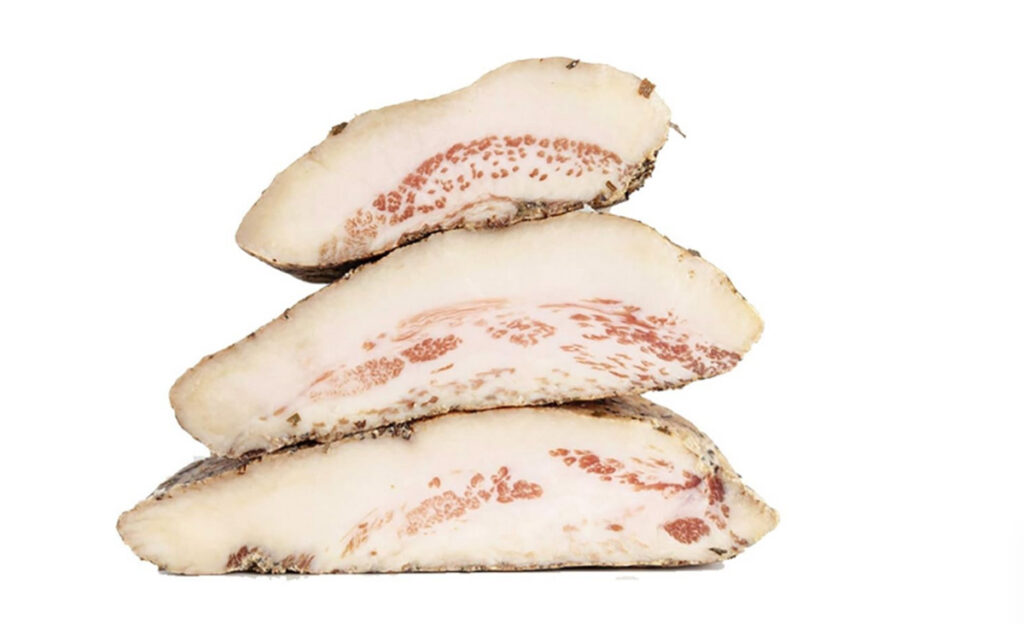
Differences Between Guanciale, Pancetta, And Bacon
Guanciale, pancetta, and bacon are all similar and come from the same animal. But there are a few key differences between them.
Guanciale
Guanciale is like extra fatty bacon. It comes from the meat between the throat and the cheek. It is seasoned and hung to cure for two months. It has a strong flavor, and a little goes a long way. Guanciale is not widely available and can be challenging to find.
Bacon
Bacon is from the belly, back, and side of the pig. And bacon is smoked, giving it a different flavor. Bacon is easy to find and available at any supermarket.
Pancetta
Pancetta comes from the belly of the pig and goes through a long curing process, making it a more expensive cut. It is cured in a salt brine and then seasoned. It isn’t usually smoked, but there are some variations that smoke it. Pancetta is often sold diced in cubes.
How to Cook Guanciale
Guanciale is cured, so you can eat it straight out of the package like prosciutto, but it tastes better cooked. The three best ways to cook guanciale are sautéing, pan frying, and baking.
Sauté Guanciale
Saute guanciale with a little olive oil and vegetables like broccoli, Brussels sprouts, or greens like Swiss chard, spinach, or kale.
Pan-fry Guanciale
Pan-fry guanciale until the fat renders and creates a creamy coating, and then add to pasta alla carbonara or any sauce.
Bake Guanciale
Bake guanciale on a baking sheet in thin pieces like bacon and add to sandwiches or eat on its own.
How to Use Italian Guanciale on Pizza
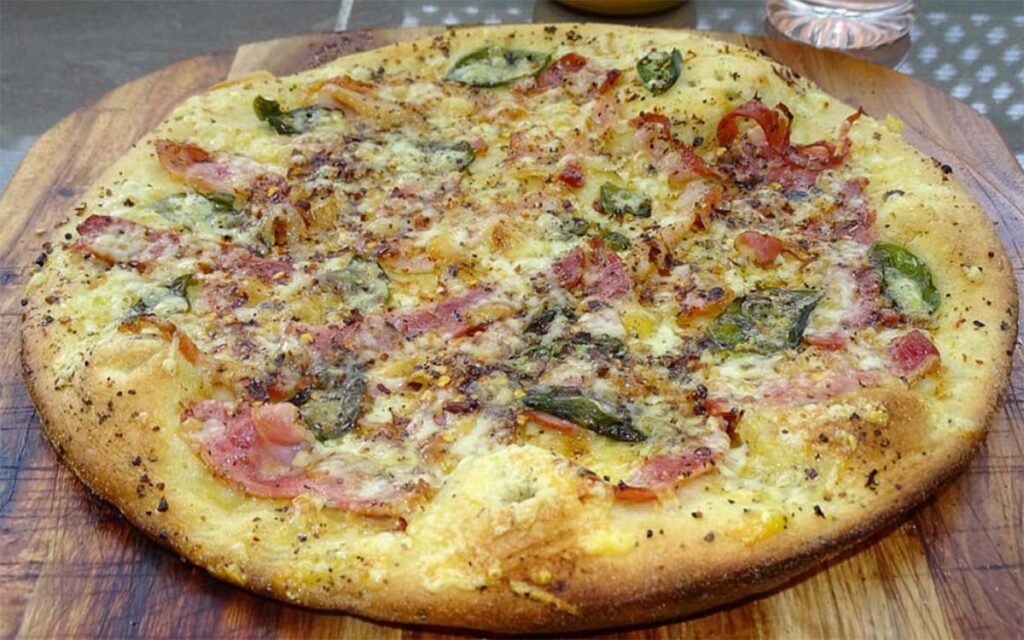
The possibilities are endless for how to use Italian guanciale on pizza. You can add it post-cooking, like prosciutto, or let it cook on top of the pizza, like Canadian bacon, or you can make a creamy sauce to drizzle over the pizza or use it instead of marinara sauce.
Here are a few of our favorite ways to add Italian guanciale to pizza.
- Guanciale with thinly sliced Brussels sprouts, Kalamata olives, and red pepper flakes.
- Guanciale with fig jam, baby spinach, and slivered almonds.
- Guanciale and egg pizza.
- Guanciale with white sauce, rosemary, and thinly sliced potatoes.
- Guanciale with roasted red peppers, caramelized onions, and mushrooms.
- Guanciale with roasted zucchini and eggplant.
- Guanciale with ricotta and roasted tomatoes.
- Guanciale with pears and blue cheese.
- Guanciale with Feta, Kalamata olives, and tomatoes.
- Swap out Canadian bacon for a Hawaiian pizza with guanciale.
- Elevate a Supreme pizza with guanciale.
Buying Guanciale
You can buy guanciale at your local Italian deli, some major supermarkets, and online. While guanciale is an Italian food, there are butchers and chefs in the U.S. and Canada who have started making it.
Since it was banned from the North American market, local producers started making small batches of artisanal guanciale. Imported guanciale can be expensive and challenging to find, so if you find yourself struggling to figure out where to get it, try American and Canadian versions.
Meat Crafters sells guanciale unsliced, so you can slice it and try using it in strips or pieces. Most supermarkets sell guanciale in precut cubes similar to pancetta.
Pro Tips
- When cooking, add very little oil and let it cook in its own fat. Low and slow is the best method.
- It has a strong flavor, much stronger than bacon, so be aware when adding to avoid overdoing it.
- Guanciale is high in salt, so avoid adding extra salt to the dish because it will provide a lot.
- When adding to a charcuterie board, [safely] use a mandoline to get thin slices.
To sum up, guanciale is an Italian cured meat made from pig jowls that has a distinct pork flavor. It is commonly used in pasta dishes like alla gricia and alla carbonara, but it is also a great addition to charcuterie boards, risottos, sandwiches, and pizza.
Guanciale differs from pancetta and bacon, which are also cured pork products. It can be cooked in various ways such as sautéing, pan-frying, and baking. Since it is high in salt, it is best to avoid adding extra salt to the dish. You can purchase guanciale at Italian delis, some major supermarkets, and online.
Have you tried Italian guanciale on pizza? What is your favorite way to add guanciale to homemade pizza?

